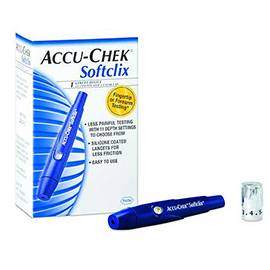![]() The Soft Touch II is the next lancing device to use after the original Soft Touch device. The newer instrument performs better than the former and has a better touch. It is also stronger than the former lancing device. With extra strength, the Soft Touch II can operate better. On the downside, there is a safety concern. The device can accidentally cut into your skin and cause serous injury.
The Soft Touch II is the next lancing device to use after the original Soft Touch device. The newer instrument performs better than the former and has a better touch. It is also stronger than the former lancing device. With extra strength, the Soft Touch II can operate better. On the downside, there is a safety concern. The device can accidentally cut into your skin and cause serous injury.
This lancing device uses the BD Ultra Fine and ComforTouch lancets. The BD Ultra Fine lancet is not made like other lancets. The metal that is inside only goes so far and is not parallel to the lancet itself. Because of the fine point on the lancet, it is one of the best ones to use for children and adults alike. This lancet is also a good fit because it’s less painful.
Putting the cap back on is simple. When the cap is put back on, the point is covered. This procedure is easy for children to do. The downside with this is, if you don’t know whether the lancet is fresh or used, you may end up causing yourself harm if you accidentally use one that was used before.
The ComforTouch is smaller in size compared to some of the other lancets on the market. This lancet can be placed into the lancing device with no problems. The lancet can be placed into the cap with relative ease. Fortunately for those who use this lancet brand, the difference between a used lancet and a new one is made clear. This brand of lancets is good for children to use.
In order to use the Soft Touch II lancing device, remove the top and you will notice a lancet compartment with a spring. The lancet is placed into the compartment and pushed toward the spring. You must allow the lancet to be pushed down as far as it will go. Take of the lancet’s safety top and it should be leaning toward the Soft Touch II lancing device.
With the lancing device, there are two tops. One is a regular top. This one is used by small children. The other one is called an extra-depth top. Children use this one also, especially when they want to ensure that they have enough blood for glucose testing.
To operate the Soft Touch II lancing device, you must slide the cocking instrument until it clicks in placed. You will know this when you hear a clicking sound. While you are doing this, it is important not to touch the tip of the lancing device. Since the lancet comes out through the hole during cocking, your fingers could be exposed to accidental injury if in the way of the lancet.
In order for the Soft Touch II lancing device to operate properly, you must exert more pressure on it. The downside with this for children is that some of them may not be able to use so much strength to execute the lancet.
The lancet should be removed after you have tested your blood glucose level. This is done when you move the cocking instrument to the front of the lancing device. Even though the tops for these devices can be used for children, overall this lancing device is not for them, due to the enormous strength that has to be used to apply the lancet process.
 The Softclix-R
The Softclix-R  The Unistik 2
The Unistik 2  It’s difficult enough for a child to find out that they have diabetes. It’s more difficult for them if they’re forced to stick themselves with needles every day, whether it’s with
It’s difficult enough for a child to find out that they have diabetes. It’s more difficult for them if they’re forced to stick themselves with needles every day, whether it’s with  The Microlet Vaculance
The Microlet Vaculance